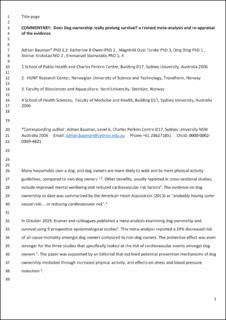| dc.description.abstract | Many households own a dog, and dog owners are more likely to walk and to meet physical activity guidelines, compared with non-dog owners.1,2 Other benefits, usually reported in cross-sectional studies, include improved mental wellbeing and reduced cardiovascular risk factors.3 The evidence on dog ownership to date was summarized by the American Heart Association (2013) as “probably having some causal role…. in reducing cardiovascular risk.”4
In October 2019, Kramer et al5 published a meta-analysis examining dog ownership and survival using 9 prospective epidemiological studies. This meta-analysis reported a 24% decreased risk of all-cause mortality among dog owners compared with non-dog owners. The protective effect was even stronger for the 3 studies that specifically looked at the risk of cardiovascular events among dog owners.5 The article was supported by an Editorial that outlined potential prevention mechanisms of dog ownership mediated through increased physical activity and effects on stress and blood pressure reduction.3
The authors calculated the ratio of deaths to the population at risk in those exposed and unexposed to dog ownership. The study reported they could only conduct an analysis of pooled unadjusted rate ratios5 (second last paragraph, p7). The Cochrane Collaboration recommends that unadjusted and adjusted estimates both be reported in meta-analyses, as the latter adjusts for important known confounders, and may produce different (risk) estimates, compared with unadjusted meta-analyses.6,7 We initially focused attention on the 6 population studies with estimates of all-cause mortality risk in the Kramer article.5 We calculated adjusted hazard ratios from these articles and re-did this meta-analysis to see if the evidence on dog ownership and mortality remained consistent. We extracted estimates from the articles that adjusted for the maximum number of covariates available, as recommended by the Cochran Collaboration6 (Table 1). We chose the identical random-effects meta-analysis methods5 namely the DerSimonian-Laird Method and the Cochran Q test and I2 values to assess heterogeneity between studies and used the Metagen package in R (R Foundation for Statistical Computing, Vienna, Austria). Where possible, the hazard ratios were extracted rather than the risk ratio, as the hazard ratio accounts for not only the occurrence of an event but also the timing of the event. | en_US |
